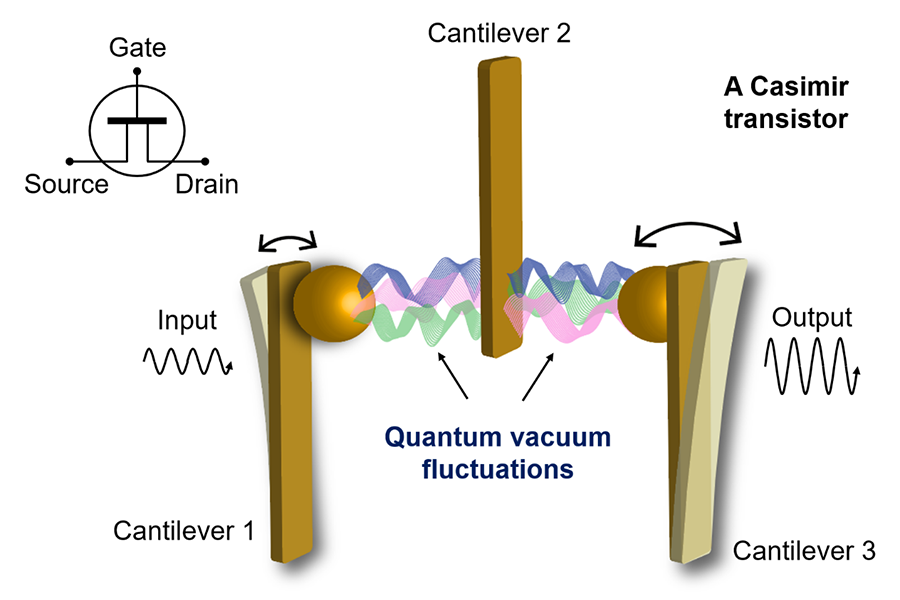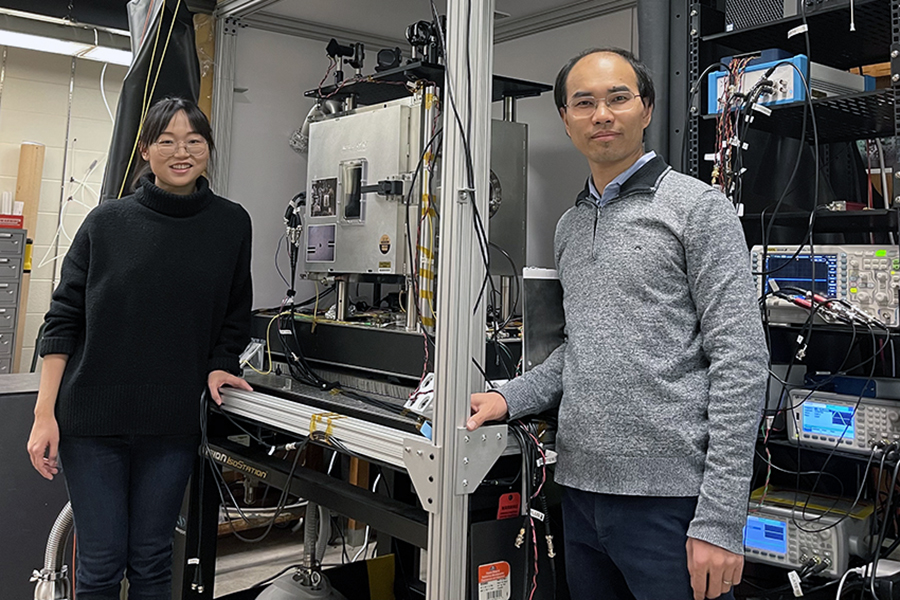Casimir analog of a transistor demonstrated at Purdue University

For the first time, researchers at Purdue University have experimentally demonstrated a transistor like device which exploits vacuum fluctuations. The terminals of this unique transistor interact through the Casimir effect, which is a force between neutral objects due to quantum vacuum fluctuations.
According to Dr. Tongcang Li, Associate Professor of Electrical and Computer Engineering and Physics and Astronomy at Purdue, it is well known theoretically that there will be Casimir force between three separate objects but it has been difficult to experimentally demonstrate the concept. The work of Li and his team, “Observation and control of Casimir effects in a sphere-plate-sphere system,” was published last week in Nature Communications.
As quantum electromagnetic fluctuations exist everywhere in the universe and in man-made devices, the Casimir effect is ubiquitous. However, Li says the Casimir effect is often neglected or treated as a detrimental effect in micro- and nano-mechanical devices.
“It will be highly desirable to change the unavoidable Casimir force from a detrimental effect to a useful resource. In this work, we demonstrated a Casimir transistor that can switch and amplify the energy transfer between three optomechanical resonators,” explains Li. “Our paper presents the first measurement of the Casimir force involving three different objects. It experimentally demonstrates an object under the Casimir force exerted by two other objects simultaneously. Although the Casimir effect has been studied by many experimentalists for several decades, all former experiments only measured the Casimir force between two objects. Before this work, most experts in this field thought it would be extremely challenging to experimentally measure the Casimir effect between three separate objects, which severely limited the investigation of the Casimir effect and its applications. Thus, our work is an experimental breakthrough and opens new possibilities in the field.”
In their experiment, the team built a unique sphere-plate-sphere Casimir system, which consists of three closely-spaced optomechanical resonators. A micrometer-thick cantilever is placed in between two microspheres which are attached to two other cantilevers. The motions of three cantilevers are monitored by three independent fiber-optic interferometers. Because of random quantum vacuum fluctuations between them, each cantilever experiences a separation-dependent Casimir force.
“We first measure the Casimir force in this three-cantilever system,” says Zhujing Xu, the lead author of this publication. “We then apply parametric modulation on the middle cantilever to couple their motions by the Casimir effect. In this way, energy can flow from the left cantilever to the middle cantilever and to the right cantilever. The center cantilever serves as a gate for controlling the energy transfer through the Casimir effect. By adding gain to the center cantilever with active feedback, we also realize amplification of the quantum-fluctuation mediated energy transfer.”
The research team for this publication and discovery are all from Purdue University. Dr. Zubin Jacob, Elmore Associate Professor of Electrical and Computer Engineering at Purdue, said the work opens new frontiers for devices which exploit vacuum fluctuations for ultra-precision metrology and sensing. Zhujing Xu, Peng Ju, Xingyu Gao, and Kunhong Shen are graduate students working with Prof. Tongcang Li in the Department of Physics and Astronomy at Purdue. Xu played a central role in this project by performing measurements and calculations. All authors contributed to the writing of the manuscript.

The idea for this research was born of a previous discovery by the team. Their previous work, Non-reciprocal energy transfer through the Casimir effect | Nature Nanotechnology, studied the Casimir effect between two objects and built a “Casimir diode” that demonstrated non-reciprocal energy transfer. In electronics, diodes (two terminal devices) and transistors (three terminal devices) are essential circuits elements. Therefore, building a Casimir transistor was a natural next step after building the Casimir diode.
This discovery could also have broad-reaching applications for devices like smart phones.
“The two major functions of an electronic transistor are switching and amplifying a voltage or a current,” says Li. “In an analog, we demonstrated switching and amplifying quantum-fluctuation-mediated energy transfer in our three-terminal Casimir system. The amplification function will be crucial for future applications of Casimir-based devices. For example, Casimir parametric amplification has been theoretically proposed for zeptometer metrology and ultrasensitive magnetic gradiometry. It may also enable us to improve the sensitivity of MEMS (microelectromechanical systems) accelerometers that are widely used in smart phones and many other devices in our everyday lives.”
Source: Casimir analog of a transistor demonstrated at Purdue University
